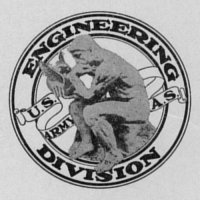USAF Engineering Division Finding Aid
Overview
 |
Since 1917, nearly all research and development activities required to equip the US Air Force and its predecessors (US Army Air Service, US Army Air Corps, US Army Air Force) with aircraft, engines, propellers and equipment was conducted or managed by the Engineering Division of the US Air Force Material Command. These ongoing R&D efforts produced a voluminous collection of data in three forms:
- Central Decimal Correspondence Files (also called the "Sarah Clark File"), 1917-1951, which consists of incoming and outgoing letters, memoranda, messages, reports and other like material relating to R&D activities
- R&D Project Case Files, 1921-1953, created by various laboratories, organizations and units of the Engineering Division and consisting of studies, test reports, technical instructions, drawings, photographs, project record books, and the like.
- Microfilmed Memorandum Reports, originally part of the R&D Project Case Files described above.
Collectively, these files document the beginnings of aeronautical development in the US and represent the investment of billions of dollars on aerospace technology.
|
Use the USAF Engineering Division Finding Aid
(please read the Instructions first )
Introduction
Most aviation enthusiasts enjoy reading books and articles about aviation that are well researched, complete and factual. Writing such works is a difficult endeavor. Source material is scattered all over the globe and is often poorly indexed. The AEHS has always strived to make it easier for authors and researchers to find material about engines and the aircraft they powered. One of the best sources in the U.S. for this kind of information is the U.S. National Archives and Records Administration, which holds aviation-related records from numerous US Government agencies, including the Federal Aviation Administration, U.S. Air Force, U.S. Army and U.S. Navy. This describes an effort by the AEHS to produce and on-line catalog (or "finding aid", in Archives-speak) that will assist researchers in using records of the U.S. Air Force Engineering Division, one of the best sources of aviation history on the planet!
Why is this necessary? What is a Finding Aid?
Most of the material that a researcher needs to write about aviation history is located in archives, not libraries. Unlike libraries where researchers can browse among the shelves of books, archives require that researchers request the material they wish to view. Archives staff members then retrieve the requested material, and return it to storage once the researcher is done with it. While in use, the material must remain in a secure “reading room” at the archives — it cannot be “checked out”. Get the subtle “Catch-22” here? One must know exactly what material to request, even if one does not know exactly what material to request!!!
To help alleviate this dilemma, archives provide “finding aids” that are similar to the card catalogs in libraries, although rarely as well organized. In the case of the records of USAF Engineering Division, the finding aid at the National Archives (NARA) is especially poor, which has resulted in the underutilization of what is probably the single most valuable source of aviation history in the United States. The condition of the USAF Engineering Division finding aid is not the fault of the National Archives — it is what was provided by the Air Force when the records were shipped from Wright Patterson Air Force Base. Since that time, the National Archives has had neither the staff nor the funding to improve on it. The AEHS has provided this searchable on-line finding aid for the records of the Engineering Division at the U.S. National Archives II.
Three major elements comprise the USAF Engineering Division historical records collection (more background). These are the Correspondence Files (also known as the Sarah Clark Files), the Research & Development Project Case Files, and the Microfilmed Memorandum Reports. The R&D Project Case Files and Memorandum Reports are further divided according to the Engineering Division organization that originated the records (or collection, as in the case of the Air Force Technical Museum). A Historical Outline for Certain Engineering Division Organizations (101K PDF) provides additional insight into Engineering Division organizations.
The AEHS finding aid allows researchers to perform keyword searches across all Engineering Division Correspondence Files and certain Engineering Division Organizations. It also allows more detailed searches within correspondence and each organization's records. Please remember that the object of this finding aid is to tell one
where the records are located at the National Archives II. With some exceptions (see below), one must still travel to the Archives (or hire an independant researcher) in order to view the records. The finding aid makes a visit to the Archives much more productive. Every record that is in this collection is part of Record Group 342. The Record Group, in conjunction with the four-digit RD # (for Correspondence and R&D Project Case Files) or Document # (for Memorandum Reports), is required to actually get the physical document box containing the desired record when one visits the Archives.
The notable excpetions to the requirement of an actual Archives visit is with the Microfilmed Memorandum reports from the Aircraft Labortory, Flight Test Division, Power Plant Laboratory and Propeller Laboratory. For these four collections one can order digitized or microfilm reporductions of complete microfilm reels from the Archives. Individual reports in digital form from the Flight Test Division, Power Plant Laboratory and Propeller Laboratory can be ordered from the AEHS (e-mail us for details)
Use the USAF Engineering Division the Finding Aid
